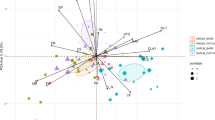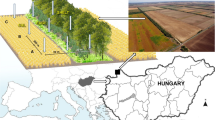Abstract
This study compared the sizes, spacings and properties (soil moisture, pH, nitrogen, soil arthropods and VAM) of soil resource islands and bare patches in sagebrush-grass communities invaded by western juniper versus those without juniper. We analyzed 1000 surface soil samples taken from nine 50-m radius circular plots sampled in December of 1991 and May of 1992 on ‘The Island’, one of the few undisturbed areas of sagebrush-grass shrubland in Oregon. Spatial structure was interpreted from correlograms (Moran's I) and standardized semivariograms. The presence of juniper was associated with increased bare area and smaller, more widely spaced grass and sagebrush plants. Soil arthropod numbers and biomass in plots with juniper were only roughly one-fifth of those in sagebrush-grass plots in December. The dominant soil pattern in both sagebrush-grass and juniper-sagebrush-grass plots was regularly-distributed patches spanning a range of sizes and spacings. Plots with juniper had greater patchiness at shorter lags (<3 m), and patchiness was more developed for soil moisture, net nitrification, and net N mineralization, whereas sagebrush-grass plots had greater patchiness at longer lags (3 – 9 m) and patchiness was more developed for NO3–N, arthropod numbers and biomass. These differences in soil patterns with and without juniper indicate that juniper responds to, or causes, changes in the size of resource islands under sage and grass when it invades sage-grass communities.
Similar content being viewed by others
References
Anderson J M and Ingram J S I 1989 Tropical soil biology and fertility: A handbook of methods. CAB International, Rothamstead.
Bartlett R. and James B 1980 Studying dried, stored soil samples - some pitfalls. Soil Sci. Soc. Am. J. 44, 721–724.
Belsky A J, Mwonga S M, Amundson R G, Duxbury J M and Ali A R 1993 Comparative effects of isolated trees on their undercanopy environments in high-and low-rainfall savannas. J. Appl. Ecol. 30, 143–155.
Belsky A J 1996 Viewpoint: Western juniper expansion: Is it a threat to arid northwestern ecosystems? J. Range Manag. 49, 53–59.
Bergelson J, Newman J A and Floresroux E M 1993 Rates of weed spread in spatially heterogeneous environments. Ecology 74, 999–1011.
Burgess T M and Webster R 1980 Optimal interpolation and isarithmic mapping of soil properties. 1. The semivariogram and punctual kriging. J. Soil Sci. 31, 315–331.
Burrough P A 1983 Multiscale sources of spatial variation in soil. II. A non-Brownian fractal model and its application in soil survey. J. Soil Sci. 34, 599–620.
Charley J L and West N E 1975 Plant-induced soil chemical patterns in some shrub-dominated semi-desert ecosystems of Utah. J. Ecol. 63, 945–963.
Cohen W B, Spies T A and Bradshaw G A 1990 Semivariograms of digital imagery for analysis of conifer canopy structure. Rem. Sens. Envir. 34, 167–176.
Cressie N 1993 Statistics for spatial data. Wiley, New York.
Driscoll R S 1964 A relict area in the Central Oregon juniper zone. Ecology 45, 345–353.
Eddleman L E 1987 Establishment of western juniper in central Oregon. In Proceedings - pinyon-juniper conference; 1986 January 13-16. Reno, NV. Ed. RL Everett. pp 255–259. General Technical Report INT-815. US. Department of Agriculture Forest Service Intermountain Research Station, Ogden UT.
EPA-600/4-79-020 1984 Methods for chemical analysis of water and wastes, Nitrogen, ammonia Method 350.1 (Colorimetric, Automated Phenate.) and Nitrogen, Nitrate-Nitrite, Method 353.2 (Colorimetric Automate, Cadmium Reduction).
Errington J G 1973 The effect of regular and random distribution on the analysis of pattern. J. Ecol. 61, 99–105.
Flanagan L B, Ehleringer J R and Marshall J D 1992 Differential uptake of summer precipitation among co-occurring trees and shrubs in a pinyon-juniper woodland. Plant Cell Environ. 15, 831–836.
Freckman D W, Cromack K and Wallwork J A 1986 Recent advances in quantitative soil biology. In Developments of Biogeochemistry: Microfaunal and Faunal Interaction in Natural and Agro-ecosystems. Eds. MJ Mitchell and JP Nakas. pp 400–416. Nijhoff/Junk, The Hague.
Giovannetti M and Mosse B 1979 An evaluation of techniques for measuring vesicular-arbuscular mycorrhizae in roots. New Phytol. 84, 489–500.
Halvorson J J, Bolton H Jr, Smith J L and Rossi R E 1994 Measuring resource islands using geostatistics. Great Basins Nat. 54, 313–328.
Halvorson J J, Smith J L, Bolton H Jr and Rossi R E 1995 Evaluating shrub-associated spatial patterns of soil properties in a shrubsteppe ecosystem using multiple-variable geostatistics. Soil Sci. Soc. Am. J. 59, 1476–1487.
Halvorson J J, Bolton H Jr and Smith J L 1997 The pattern of soil variables related to Artemisia tridentata in a burned shrub-steppe site. Soil Sci. Soc. Am. J. 61, 287–294.
Hook P B, Burke I C and Lauenroth W K 1991 Heterogeneity of soil and plant N and C associated with individuals plants and openings in North American shortgrass steppe. Plant Soil 138, 247–256.
Hook P B, Lauenroth W K and Burke I C 1994 Spatial patterns of roots in a semiarid grassland: Abundance of canopy openings and regeneration gaps. J Ecol 82, 485–494.
Ingham R E, Trofymow J A, Ingham E R, Ames R N, Hunt H W, Morlay C R, Moore J C and Colman D C 1986 Trophic interactions and nitrogen cycling in a semi-arid grassland soil. II. System responses to removal of different groups of soil microbes or fauna.J. Appl. Ecol. 23, 615–630.
Jackson R B and Caldwell M M 1993a The scale of nutrient heterogeneity around individual plants and its quantification with geostatistics. Ecology 74, 612–614.
Jackson R B and Caldwell M M 1993b Geostatistical patterns of soil heterogeneity around individual perennial plants. J. Ecol. 81, 683–692.
Keeney D R and Nelson D W 1982 Nitrogen-inorganic forms. In Methods of soil analysis, part 2. Eds. AL Page, RH Miller and DR Keeney. Agron. Monogr. 9, Am. Soc. Agron., Madison, Wisconsin.
Knapp P A and P T Soule 1996 Vegetation change and the role of atmospheric CO2 enrichment on a relict site in central Oregon: 1960-1994. Ann. Assoc. Am. Geogr. 86, 387–411.
Kramer S, Miller P M and Eddleman L E 1996 Root system morphology and development of seedling and juvenile Juniperus occidentalis. Forest Ecol. Manag. 86, 229–240.
Legendre P and Fortin M J 1989 Spatial pattern and ecological analysis. Vegetatio 80, 107–138.
Leighty WJ 1958 Soil Survey, Deschutes area, Oregon. (Correlation by A.E. Kocher and J. W. Leighty.) Soil Survey, ser. 1945, no 2. U.S. Govt. Print Office, Washington DC.
Levin S A 1992 The problem of pattern and scale in ecology. Ecology 63(6), 1943–1967.
Merchant V A and D A Crossley 1970 An inexpensive, high efficiency Tullgren extractor for soil microarthropods. Georgia Entomol. Soc. J. 5, 83–87.
Miller R F, Angell R F and Eddleman L E 1987 Water use by western juniper. In Proceedings - pinyon-juniper conference; 1986 January 13-16. Reno, NV. Eds. RL Everett. pp 418–422. General Technical Report INT-815. US Department of Agriculture Forest Service Intermountain Research Station, Ogden, UT.
Neter J, Wasserman W and Kutner M H 1990 Applied linear statistical models: regression, analysis of variance and experimental designs. Irwin, Homewood, IL.
Padien D J and Lajtha K 1992 Plant spatial pattern and nutrient distribution in pinyon-juniper woodlands along an elevational gradient in northern New Mexico. Int. J. Plant Sci. 163, 425–433.
Phillips J M and Hayman D S 1970 Improved procedures for clearing roots and staining parasitic and vesicular-arbuscular mycorrhizal fungi for rapid assessment of infection. Trans. Brit. Mycol. Soc. 55, 158–161.
Polis G A, Anderson WB and Holt R D 1997 Toward an integration of landscape and food web ecology: The dynamics of spatially subsidized food webs. Annu. Rev. Ecol. Syst. 28, 289–316.
Rabatin S C and Stinner B R 1985 Arthropods as consumers of vesicular-arbuscular mycorrhizal fungi. Mycologia 77, 320–322.
Roberts C 1994 Spatial relationships of vesicular-arbuscular mycorrhizae, soil fauna and soil nutrients in the juniper-sagebrushgrass communities of central Oregon. MS thesis, Department of Forest Science, Oregon State University, Corvallis, OR, USA. Rossi R E, Mulla R J, Journel A G and Franz E H 1992 Geostatistical tools for modeling and interpreting ecological spatial dependence. Ecol. Monog. 62, 277–314.
Ryel R J, Caldwell MM and Manwaring J H 1996 Temporal dynamics of soil spatial heterogeneity in sagebrush-wheatgrass steppe during a growing season. Plant Soil 184, 299–309.
Santos P F, Phillips J and Whitford W G 1981 The role of mites and nematodes in early stages of buried litter decomposition in a desert. Ecology 62, 664–669.
Schlesinger W H, Reynolds J F, Cunningham G L, Huenneke L F, Jarrell W M, Virginia R A and Whitford W G 1990. Biological feedbacks in global desertification. Science 247, 1043–1048.
Schlesinger W H, Raikes J A, Hartley A E and Cross A F 1996 On the spatial patterns of soil nutrients in desert ecosystems. Ecology 77, 364–374.
Smith J L, Halvorson J J and Bolton H Jr 1994 Spatial relationships of soil microbial biomass and C and N mineralization in a semi-arid shrub-steppe ecosystem. Soil Biol. Biochem. 26, 1151–1159.
Sokal R R and Oden N L 1978 Spatial autocorrelation in biology. 1. Methodology. Biol. J. Linnean Soc. 10, 199–228.
Stanford G, Carter J N and Smith S J 1974. Estimates of potentially mineralizable soil nitrogen based on short-term incubations. Soil Sci. Soc. Am. Proc. 38, 99–102.
Stanford G and Smith S J 1972 Nitrogen mineralization potential of soils. Soil Sci. Soc. Am. Proc. 36, 465–472.
Steel R G D and Torrie J 1980 Principles and procedures of statistics, a biometrical approach. 2nd Edn. McGraw-Hill, New York.
Torgerson C, Jones J A, Moldenke A and LeMaster M P 1995 The spatial heterogeneity of soil invertebrates and edaphic properties in an old growth forest stand in western Oregon. In The Significance and Regulation of Soil Biodiversity. Eds. HP Collins, GP Robertson and MJ King. pp 225–236. Kluwer Publications, Dordrecht, The Netherlands.
Trappe J A 1981 Mycorrhizae and productivity of arid and semiarid rangelands. In Advances in Food Producing Systems for Arid and Semiarid Lands. pp 581–599. Academic Press, New York.
Turner M G 1989 Landscape ecology: The effect of pattern on process. Annu. Rev. Ecol. Syst. 20, 171–197.
Wallwork J A 1976 The distribution and diversity of soil fauna. Academic Press, London.
Whitford W G 1986 Soil fauna as regulators of decomposition and nitrogen cycling in pinyon-juniper ecosystems. In Proceedings - pinyon-juniper conference; 1986 January 13-16 Reno, NV. Ed. RL Everett. General Technical Report INT-815. U.S. Department of Agriculture Forest Service Intermountain Research Station, Ogden, UT.
Wilkinson L, Blank G and Gruber C 1996 Desktop data analysis with SYSTAT. Prentice-Hall, Upper Saddle River, NJ.
Author information
Authors and Affiliations
Rights and permissions
About this article
Cite this article
Roberts, C., Allen Jones, J. Soil patchiness in juniper-sagebrush-grass communities of central Oregon. Plant and Soil 223, 47–61 (2000). https://doi.org/10.1023/A:1004745329332
Issue Date:
DOI: https://doi.org/10.1023/A:1004745329332




